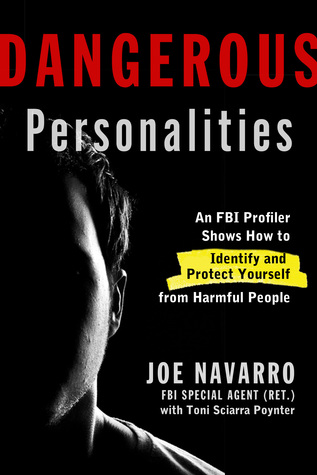Retired FBI special agent Joe Navarro gives the reader the tools to identify the four most dangerous personality types. After decades of profiling criminals, he categorizes these dangerous personalities as:
- The Narcissist: “It’s all about me”
- The Emotionally Unstable: “Fasten your seat belts . . .”
- The Paranoid: “Trust no one and you’ll never get hurt”
- The Predator: “What’s mine is mine–and what’s yours is mine”
I read this book because A) I want to learn how to protect myself and family; B) I am curious about criminals and the criminally-minded (probably from reading crime fiction); and C) I want to recognize those who are dangerous, even if I am not directly under their influence.
What didn’t work for me:
Dangerous Personalities skims the surface.
This is a broad subject and there are many things the general public doesn’t know about the most dangerous personality types. We’re left with a shallow understanding of the narcissist, the emotionally unstable, the paranoid, and the predator. There are descriptions of these people’s behavior but not enough to help the lay person fully understand it.
To Navarro’s credit, he states as much. He’s not interested in telling us why a particular personality behaves the do, the origins of the disorders, or the ways to help these people. He states, over and over, that help for people like the predator (or narcissist, etc.) must be left to professionals, and that it may not even be possible. (Is that too pessimistic? Maybe it’s possible but not probable for them to change.)
His goal is to help readers
- identify dangerous people in their lives and
- escape their influence.
As he points out, those victims who are left cleaning up the mess of a destructive personality probably don’t care about why that person was destructive (what made him/her so destructive in the first place). He describes the effect these types of people have on others.
What worked for me:
1. Navarro recounts stories of victims and criminals.
Some stories are haunting, such as Sue Curtis, one of Ted Bundy’s victims, who disappeared from a college campus the night Navarro was on patrol duty. He possibly saw Bundy cruising around the campus. Navarro conducted the initial investigation, but she was never found. (Bundy confessed to killing her prior to his execution.)
Navarro’s sorrow that he didn’t recognize Bundy as a predator and his failure to solve the case and find young Sue haunts me. It’s obvious that Navarro, even years later, feels pain over this and many other cases that he writes about. But his pain has driven him to want to help prevent these crimes by giving readers the tools they need to recognize and escape.
The stories are informative. While I didn’t have this experience, some readers may recognize their current situation and, I hope, take action. Others may recognize situations that friends or family are dealing with, too.
2. The easy reading level is helpful.
People who might be lost in a book of theories, technical terms, etc., will be able to read this. The stories will hold their attention better, too.
Stories stick in my head better than stats or theories. That’s helpful. If I were to find myself in certain situations, I might remember a similar story and use it as a basis for my actions. I’d never remember instructions!
His writing voice is engaging and personable. I was left with the sense of a man who cares deeply about others and cares about passing on the hard-won knowledge he has found.
3. Navarro ends each chapter with suggestions for immediate action.
These are generally good. But I would have liked to have seen more ways that friends/family can help those in danger. For example, I may not be an abuse victim but I might have a friend/neighbor/acquaintance who is. I’d like to have the tools to step in and help.
4. Each chapter contains lengthy (100+) statement checklist of characteristics of each personality.
For example the narcissist “is unable to identify the needs, wants, desires, and feelings of those closest to her.” The predator “has a sense of entitlement and thinks he is above others or he can do as he pleases.” (He uses gender pronouns interchangeably. Both genders can be dangerous!)
He urges readers to think carefully about the possible dangerous person in their lives, work through the entire list (which contains some items I never would’ve thought of), and add up the scores.
Conclusion:
If you’re looking for in-depth understanding of this subject, theories about personality disorders, statistics about crime, or clinical help, Dangerous Personalities is not the book for you. However, Navarro includes a lengthy bibliography for further research. I plan to photograph this and use it for future reference.
If you enjoyed Dangerous Personalities, you may also enjoy Predators: Who They Are and How to Stop Them, by Gregory M. Cooper and Michael R. King, with Thomas McHoes. Okay, not enjoy. You might find it useful. I certainly did. Also check out my list of books about predators and how to protect yourself from them.

